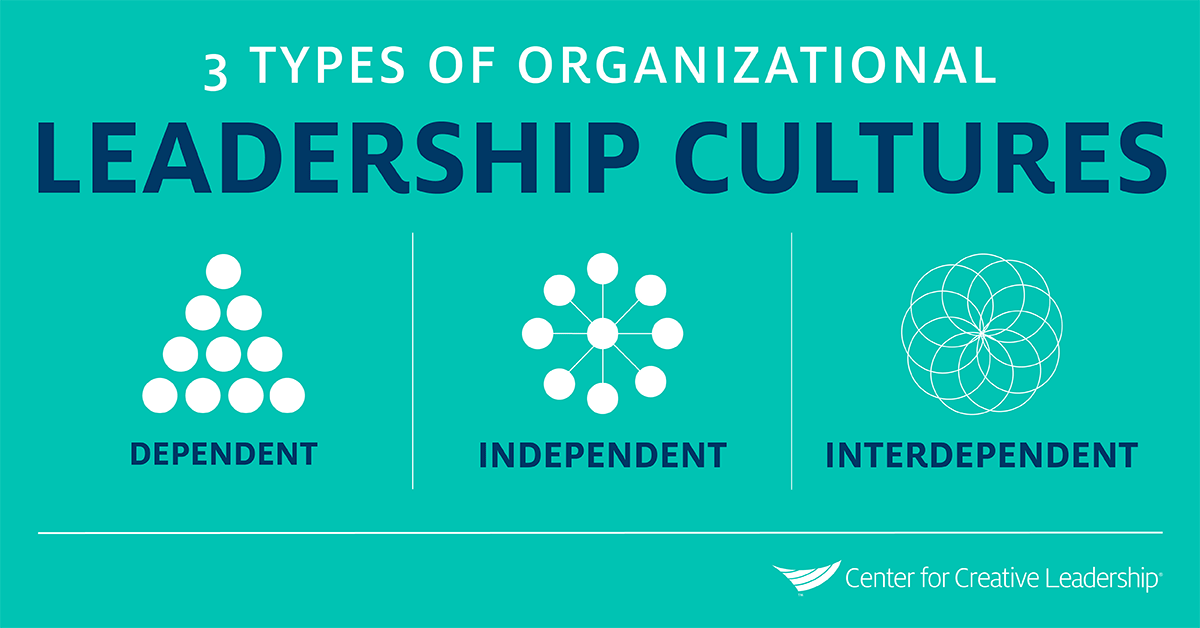When leaders execute their organization’s business strategies, they can’t forget their organization’s culture — the self-reinforcing web of beliefs, practices, patterns, and behaviors — because, as has often been said, culture trumps strategy every time.
Your organization’s culture is the way things are done; it’s the way people interact, make decisions, and influence others. Leaders’ own conscious and unconscious beliefs drive decisions and behaviors, and repeated behaviors become leadership practices. Because these practices eventually become the patterns of your organization’s leadership culture, leaders must understand their responsibility in creating — or changing it.
And the type of organizational culture you have, combined with how your organization approaches and understands the definition of leadership itself, together dictate how successful your business strategies will be.
3 Types of Organizational Leadership Cultures
Dependent, Independent, and Interdependent
In our research, we describe organizational leadership cultures in a hierarchy of 3 types:
- Dependent leadership cultures operate with the belief that people in authority are responsible for leadership.
- Independent leadership cultures operate with the belief that leadership emerges out of individual expertise and heroic action.
- Interdependent leadership cultures operate with the belief that leadership is a collective activity to the benefit of the organization as a whole.
And in our experience, we’ve found that organizations, like people, tend to evolve along a path over time, moving from dependent to independent to interdependent leadership cultures. Each successive culture moves the organization to a greater level of capability for dealing with complexity and accelerated change.
But how do you identify the organizational leadership culture that you have at your organization? And going even further, how can you determine whether you have the culture you need for the strategy you’ve set?
How to Identify Your Organization’s Leadership Culture
One way to decode what type of organizational culture you have is to assess how leaders go about creating direction, alignment, and commitment (DAC), which are the outcomes of leadership, at your organization. DAC is a key part of how leadership works in organizations.
The process of creating DAC may vary greatly from organization to organization, depending upon the predominant type of organizational culture, as shown below and explained in our white paper.
| DIRECTION How do we achieve agreement on direction? |
ALIGNMENT How do we coordinate our work so that all fits together? |
COMMITMENT How do we maintain commitment to the collective? |
|
|---|---|---|---|
| INTERDEPENDENT | Agreement on direction is the result of shared exploration and the emergence of new perspectives. | Alignment results from ongoing mutual adjustment among system-responsible people. | Commitment results from engagement in a developing community. |
| INDEPENDENT | Agreement on direction is the result of discussion, mutual influence, and compromise. | Alignment results from negotiation among self-responsible people. | Commitment results from evaluation of the benefits for self while benefiting the larger community. |
| DEPENDENT | Agreement on direction is the result of willing compliance with an authority. | Alignment results from fitting into the expectations of the larger system. | Commitment results from loyalty to the source of authority or to the community itself. |
Direction
Direction determines how your organization decides on a way to go. Looking at the chart above, you can see that, depending upon the type of organizational culture you have, the approach to setting direction could be primarily rooted in compliance (in dependent cultures), influence (in independent cultures), or shared exploration (in interdependent cultures).
Alignment
Alignment refers to how you coordinate your work so that it fits together. Similar to direction, the approach to creating alignment varies depending upon your organization’s culture and maturity. In dependent cultures, alignment results from fitting into the expectations of the larger system. In independent cultures, it results from negotiation. And in more mature, interdependent cultures, it results from ongoing mutual adjustment.
Commitment
Commitment speaks to mutual responsibility for the group — when people prioritize the success of the collective over their individual success. In dependent cultures, that commitment results from loyalty to the source of authority of the community itself. In independent cultures, it results from evaluating the benefits for self while benefiting the larger community. And in interdependent cultures, commitment results from engaging in a developing community.
Is Your Leadership Strategy in Sync With Your Organizational Culture?
You may be able to see how, as you move through the levels and types of organizational culture, that the most mature types of organizational cultures are interdependent. (Curious to learn more? Discover the 5 principles for interdependent leadership.)
Once you have identified what type of organizational leadership culture you have now, it’s time to ask:
- To what extent is our culture having a positive or negative impact on performance?
- Is our culture helping us to achieve the business strategies we’ve set?
If your business strategy and leadership culture are at odds, your leaders need to get serious about changing themselves — so they can create greater direction, alignment, and commitment and, over time, boost performance and meet strategic business goals. This is especially critical if you’re about to embark on a large-scale change initiative. Are your leaders ready and able to help you transform your organization?
For optimal outcomes, you must carefully link your business strategy, leadership strategy, and organizational culture. And make sure that your organization’s leadership development initiatives are aligned and crafted to support these, as well.
Ready to Take the Next Step?
Partner with our experts to identify what type of organizational culture you have and ensure that your leadership culture and strategy are aligned. Learn more about our approach to Organizational Leadership Culture Change.











